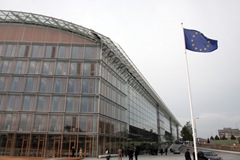Meeting the renewable criteria
 agendaNi speaks to Jean-Christophe Chaline, the European Investment Bank’s head of lending in Western Europe, about the criteria which must be fulfilled in order to receive funding for energy projects, a high priority for the institution.
agendaNi speaks to Jean-Christophe Chaline, the European Investment Bank’s head of lending in Western Europe, about the criteria which must be fulfilled in order to receive funding for energy projects, a high priority for the institution.
Last year renewable energy projects in Ireland and the UK received over €1 billion funding from the European Investment Bank (EIB) and throughout the continent, the bank spent 33 per cent of its €14 billion budget on energy. According to Jean-Christophe Chaline, the renewables sector is “where we expect most growth in 2010.”
The EU policy directive on renewable energy states that the 27 member states must reach a collective 20 per cent share of energy from renewable sources by 2020. This equates to 15 per cent for the UK and 16 per cent for Ireland.
Since 2005 the EIB has spent over €22 billion in the UK, of which just over €4 billion was spent on energy. The bank has pledged to provide £700 million over the next three years for new on-shore wind projects in the UK costing between £20 and 100 million. Projects currently include six wind farms in Scotland and various structures which are currently at financial closure or construction stages in the rest of the UK.
In Ireland ongoing EIB-funded projects include: the Aghada Gas Fired Power Station in County Cork; the €300 million Eirgrid East-West Interconnector (a 260km partly undersea cable, which will carry 500MW between Dublin and Wales); and a €200 million portfolio of wind farms that ESB is putting together over the next three years. In addition, the bank lent €300 million to Dublin Airport for its new terminal.
On-shore wind farms are the EIB’s main areas of financing, along with solar, hydro, geo-thermal and photovoltaics.
Chaline cites his interest in the Eirgrid East-West interconnector which is “the biggest energy project we financed” in Ireland to date.
Criteria
Chaline explained that the EIB has three types of finance operation for onshore wind projects. Direct loans to corporate banks are used for large scale programmes covering several wind-farm schemes over a period of three to four years at a minimum investment cost of €400 million. A project/structured finance facility is used for projects with a higher risk profile, costing a minimum of €100 to €150 million (such as the Alto Minho Parques Eólicos windfarm in Portugal.) And, intermediated loans take place when the EIB work through partner banks on small and medium sized projects with investment of €50 to €100 million, where the lending decision lies with partner banks.
Before funding is considered a project must meet at least one of EIB’s objectives on sustainable, competitive and secure energy. It must be technically sound, with a minimum of one year of valid on-site wind measurements (if it is a wind project). A reasonable timeframe between construction and start of commercial operation is required and planning consent and a firm grid connection offer must be in place. Projects must be financially viable and show an acceptable economic return, comply with environmental protection and procurement regulations, and the borrower must have the capacity for loan repayment and not pose a risk to the EIB.
Depending on the complexity of the project and the availability of information, developers can expect a four to six month time-frame where their request is initially checked for compliance to the EIB’s eligibility criteria. It then goes through economic, financial, technical, environmental and social staff teams before it is passed on to the management committee. From there, the request goes to the lawyers who formulate a contract negotiation. Finally, the project is presented to the board of directors for loan approval.
Going forward, Chaline predicts solar energy will rise in popularity in countries such as Spain, France, Italy, Greece and Germany and also foresees “increased demand in the areas of housing, transportation and smart metering” in the next two years.





